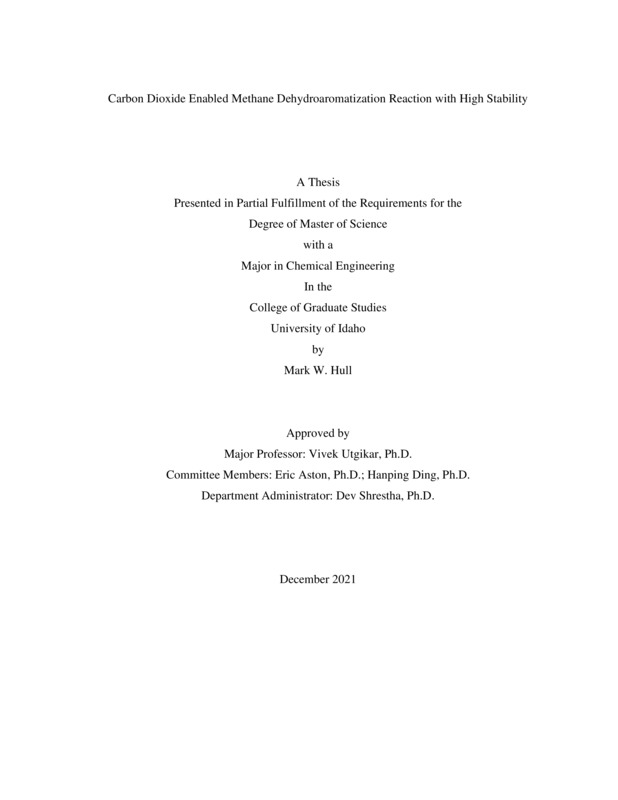Carbon Dioxide Enabled Methane Dehydroaromatization Reaction with High Stability
Hull, Mark. (2021-12). Carbon Dioxide Enabled Methane Dehydroaromatization Reaction with High Stability. Theses and Dissertations Collection, University of Idaho Library Digital Collections. https://www.lib.uidaho.edu/digital/etd/items/hull_idaho_0089n_12270.html
- Title:
- Carbon Dioxide Enabled Methane Dehydroaromatization Reaction with High Stability
- Author:
- Hull, Mark
- ORCID:
- 0000-0003-1428-3948
- Date:
- 2021-12
- Keywords:
- Arc Quenching Benzene Carbon Dioxide Methane Dehydroaromatization Propyne Ryuichiro Ohnishi
- Program:
- Chemical and Materials Science Engineering
- Subject Category:
- Chemical engineering
- Abstract:
-
Benzene has been found to be used in over sixty percent of all industrially made chemicals. However, with a societal desire to be less dependent on fossil fuels, this unknowingly hurts benzene production. Although there are other alternatives to making benzene, methane dehydroaromatization proves to be the most efficient option. There have been many studies about MDA, however, few studies have been conducted to show that gas additions can improve the reaction. One study went over the effects of a carbon dioxide addition within the gas stream. The study showed that carbon dioxide is in competing nature with methane but stabilizes the reaction to a small degree. The work conducted in this report is to give a more detailed account of how carbon dioxide affects the MDA reaction. Carbon dioxide can increase the reaction’s lifetime by over 700% (55-60 hours) but is most effective when its reaction time is held just above 20-25 hours (200% lifetime increase). With a carbon dioxide addition of 3 vol%, the reaction can keep a benzene selectivity of over 70% for its 25 hour lifetime. Of all the carbon dioxide values tested, 3 vol% addition provided the best results in terms of maintaining high conversion (~15%) and the highest selectivity (>70%). Carbon dioxide’s role was theorized to help stabilize the reaction by transforming methane into a more reactive species: methanol. Using temperature programmed desorption, it was also theorized that propyne is the main reactant in forming benzene. Propyne polymerization is a well known process, and it was theorized since propyne is the major product found on the catalyst’s surface that propyne polymerization occurs to create mesitylene. Mesitylene is then hydrocracked to form methane and benzene. Further investigations revealed that carbon dioxide has the properties of arc quenching. This allows it to absorb free electrons without altering its physical chemistry. It was finally theorized that with a 3 vol% carbon dioxide addition, the optimal ratio of oxygen addition to electron removal of the reaction can be achieved.
- Description:
- masters, M.Engr., Chemical and Materials Science Engineering -- University of Idaho - College of Graduate Studies, 2021-12
- Major Professor:
- Utgikar, Vivek
- Committee:
- Aston, Eric; Ding, Hanping; Shrestha, Dev
- Defense Date:
- 2021-12
- Identifier:
- Hull_idaho_0089N_12270
- Type:
- Text
- Format Original:
- Format:
- application/pdf
- Rights:
- In Copyright - Educational Use Permitted. For more information, please contact University of Idaho Library Special Collections and Archives Department at libspec@uidaho.edu.
- Standardized Rights:
- http://rightsstatements.org/vocab/InC-EDU/1.0/

